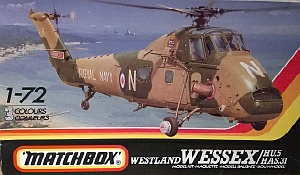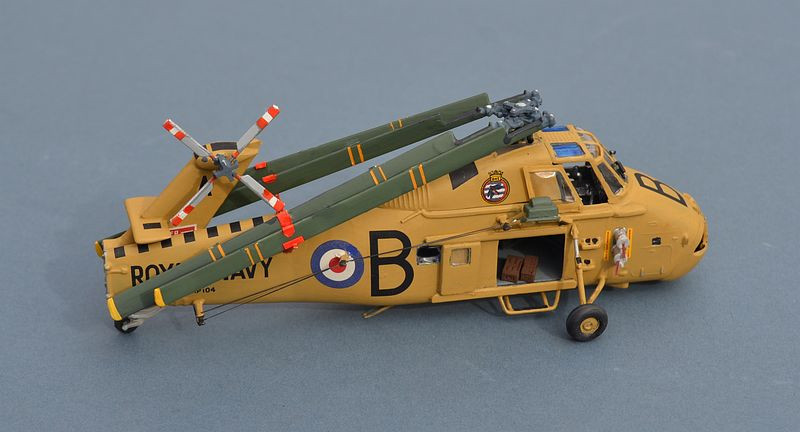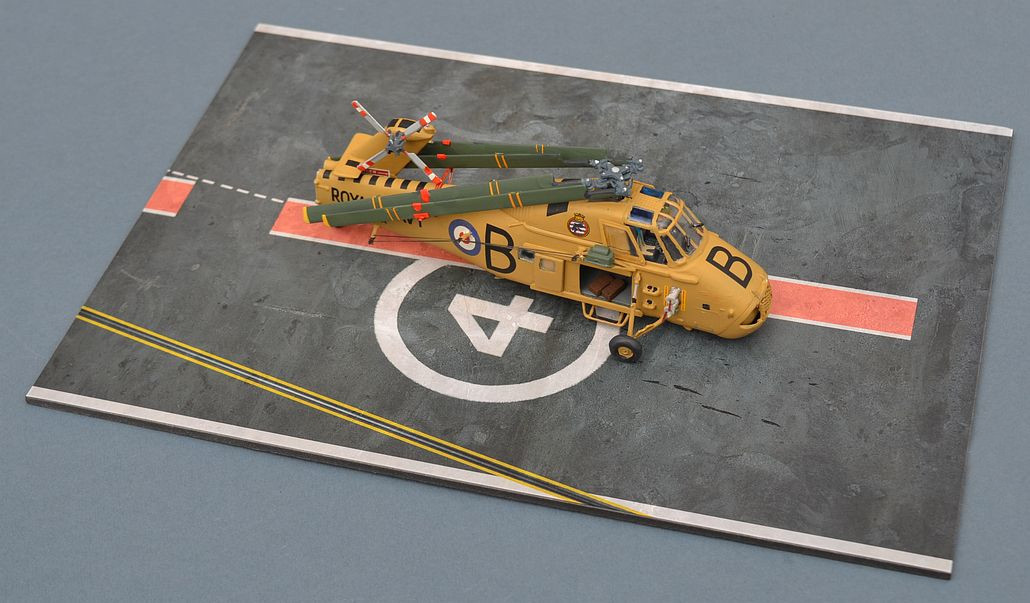Westland Wessex HAS.1 “Jungly”
845 Naval Air Sqn, HMS ALBION -
Far East Fleet, South China Sea / Borneo 1962
Matchbox 1/72 with FROG Decals
On its introduction to service in 1961, the gas turbine powered Wessex marked a step
change in the Royal Navy’s anti-
With advanced avionics, the ability to carry the latest NATO Mk.44 homing torpedoes
and a US-
Like the Whirlwind that preceded it, the RN quickly realised that the Wessex would make an ideal troop carrier. Stripped of their ASW equipment, to enable the carriage of up to 16 fully loaded Royal Marines or a 4,000lb load, early Mk.1 Wessexes were allocated to 845 Sqn in April 1962 and embarked in HMS ALBION, deployed to the Far East for 3 years in response to the rebellion in Brunei and the related Indonesian Confrontation.
Operating over the jungle terrain and from sparsely equipped clearings, with deep support from ALBION offshore, the helicopters transported Royal Marines and Army troops to areas that were otherwise inaccessible, gaining the RN Commando helicopter force the enduring nickname of “the Junglies”.
XP104, the aircraft that my model represents, was converted into a HAS.3, then lost in January 1972 when its engine failed and it crashed into the sea near Delimarra in Malta, whilst operating with 820 Sqn from HMS BLAKE. Fortunately the 3 aircrew survived the crash. This was its second crash, the first having been a hard landing in Brunei in January 1963, but on that occasion it was repaired and returned to service.
Link to many more RN Helicopters on my Helicopters pages
Building the Matchbox Wessex kit (again!):
This is my 4th build of a Matchbox Wessex, the first of which was just after it was
first released in 1987. The kit is one of Matchbox’s best, with some surprisingly
good details and a shape that is generally quite good, albeit that the nose of the
base Mk V variant isn’t quite the right shape.  That said, it has some advantages
over the later Revell/Italeri kits, for example in the way that it sits on its undercarriage.
That said, it has some advantages
over the later Revell/Italeri kits, for example in the way that it sits on its undercarriage.
The kit provides an alternative nose for an Australian Mk.31, although it lacks, for example the underside changes that would be needed. Nevertheless, the nose is an ideal starting point for a British Mk.1 and I have already built one of these as an anti submarine hunter, using Xtradecal markings. This time, I intend to build it as a troop carrier, in the distinctive pale stone colours seen on its early deployments (I will save the sand and spinach scheme for a later Mk.V build!)
Decals come from an old FROG kit (with a few details from the Matchbox original),
and like most FROG decals from that era, they remain perfectly usable (and un-
Below: © IWM (A 34659A) Lifting a field Howitzer
Contemporary pictures show the aircraft flying in Brunei with the cabin door removed entirely or replaced with a unusual “half door” (whose function isn’t entirely clear to me) at the aft end of the rails. Its also obvious that they don’t always have the cabin door winch fitted, nor do they have the wheel floats in place. In some cases, a part cabin door seems to be fitted, so I have gone with this, by chopping the kit door in two. Fitting it showed a possible shortfall of the Matchbox kit, as my pictures show the door window covering the fuselage window, bu t the kit has the latter much further back
Adding the optional nose is a straightforward evolution, although you do have to cut the old nose off with some care. Smoothing the joint between new nose and fuselage afterward is a little awkward as it isn’t easily accessible. The 2 part exhaust nozzles are difficult to get smooth and needed a tiny smidgeon of filler to give them even ends. As I intend to fold the main rotors, for this build I have decided to use the options that Matchbox have provided and fold the tail as well. This required a little more thought on my plastic strip blade crutch, as the folded tail rotor needs to fit inside the blades.
My reference pictures show this particular aircraft without the cabin door hoist, but others “in theatre” seem to have them, so once more, since it is in the box, I added it. I can also see that some aircraft have the wire antennae and some don’t. Having already fitted the pylons when I noticed this, I have gone ahead with them, although I suspect they are not correct. They do, however, add a lot of detail and interest to the finished model !
My undercarriage legs caused some problems -

November 2024 Part 2
Westland Wessex HAS.1
Hiller HT.1


Below: © IWM (A 34681) Royal Marines disembarking in the desert











At this point, with the blades not yet attached, but everything else complete, I applied the paint (mainly Humbrol 94) and the decals. The FROG decals worked well, although they are a little stiff and unstretchy which didn’t help the larger ones to conform to the surface. In the end I only used a few of the Matchbox decals, the white and red fire door marking on the nose and the main rotor blade lifting / storage lines. In retrospect, I believe the decals are a little overscale, with the roundel and the “Royal Navy“ titles showing this.
A final coat of Windsor & Newton acrylic matt varnish set me up nicely to attach the tail rotor and folded main blades. The blade fold is fairly straightforward on this type of helicopter, and having done one several times before, I now know how to get it right. I added blade crutches made from plastic strip, then assembled the main rotor hub in place. The blades were then glued to the hub in their folded positions and orientations, remembering that one side points up and the other down. I found a little uncertainty with the blade colours, with some sources suggesting the tail rotor should be silver, and others grey (I went for grey). The tops of the main rotors also seem to be grey in some sources, but other references suggest green on top and black below, which is what I have gone for.
Wire antenna were made from my usual lycra thread, attached with CA glue.
The FROG decals worked well, although they are a little stiff and unstretchy which didn’t help the larger ones to conform to the surface. In the end I only used a few of the Matchbox decals, the white and red fire door marking on the nose and the main rotor blade lifting / storage lines. In retrospect, I believe the decals are a little overscale, with the roundel and the “Royal Navy“ titles showing this.
This is a reasonable kit for its time and origin, with several shortfalls that are
only partly addressed by the more recent Italeri Wessex kits. The Matchbox nose
is definitely too flat and the windscreen needs more curve on its lower surface.
However, it is certainly more detailed than the FROG kit (whose shape may be better)
and does not have some of the obvious shortfalls of the Italeri kit (especially
that kit’s nose-


Above: The Matchbox MK.V / Mk.31 markings.
Right: -


Above: © IWM (A 34658) Royal Marines board a Wessex off Aden
Below: All my Wessex models to date. From Left, S58 Wessex prototype, HAS.1, HAS.1, HAS.3, HAR.5, HU.5.